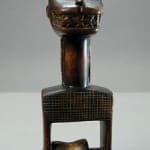Baule Wooden Heddle Pulley, 20th Century CE
Wood
7 x 19.1 cm
2 3/4 x 7 1/2 in
2 3/4 x 7 1/2 in
PF.5949 (LSO)
Further images
This striking object is a heddle pulley, and was made by the Baule, a subsection of the Ivory Coast Akan polity. The looming end is a conventional form, with cross-hatching...
This striking object is a heddle pulley, and was made by the Baule, a subsection of the Ivory Coast Akan polity. The looming end is a conventional form, with cross-hatching designs and an integrated spindle. The handle is formed into the likeness of a monkey head, known as “Mbra” (or Gbreke), who is a potent symbol for the Baule. Full-sized versions of this creature are often stood up in Baule villages and are used to assist in divination rituals. They are considered so powerful that women are not allowed to see them. Their fearsome appearance is boosted by the application of encrusted patinas that are the result of repeated libations of dog blood (dogs are sacrificed to this end). The Baule fascination with decorating utilitarian objects is more explicative than any specific magical connotation in the present case; it is unlikely that Mbra would have been invoked to assist in such a comparatively mundane activity as weaving, and it is the decorative aspect of the carving which appealed to the person who originally commissioned this attractive piece
The Baule live across the Ivory Coast area, and have an economy based primarily on sedentary agriculturism. They have thus been able to build up a considerable political and economic stronghold, which has in turn given rise to a strong ritual and artistic heritage. Their own creation story relates to an ancient migration, in which the queen was forced to sacrifice her son in order to ford a mighty river. So upset was she that all she could say was “baouli” (“the child is dead”), thus giving rise to the tribe’s name.
Blolo bian (male) and Blolo bla (female) spirit spouses are perhaps the Baule’s greatest artistic and psycho-social achievement. These figures are otherworldly partners for young men and women, and are designed as perfect women/men who provide spiritual assistance to their earthly spouses. The Baule are also known for sculptures representing bush spirits (Asie usu) – mischievous and potentially malevolent inhabitants of the “bush”, or dark country beyond the boundary of the village – monkeys, and three types of masks that are used in the celebration of good harvests, mourning, and the visits of important dignitaries.
Secular items are also known, including heddle pulleys, doors, catapults and other utilitarian objects that are often decorated to a very high standard by Baule artists and craftsmen. This is an outstanding example of this tradition.
The Baule live across the Ivory Coast area, and have an economy based primarily on sedentary agriculturism. They have thus been able to build up a considerable political and economic stronghold, which has in turn given rise to a strong ritual and artistic heritage. Their own creation story relates to an ancient migration, in which the queen was forced to sacrifice her son in order to ford a mighty river. So upset was she that all she could say was “baouli” (“the child is dead”), thus giving rise to the tribe’s name.
Blolo bian (male) and Blolo bla (female) spirit spouses are perhaps the Baule’s greatest artistic and psycho-social achievement. These figures are otherworldly partners for young men and women, and are designed as perfect women/men who provide spiritual assistance to their earthly spouses. The Baule are also known for sculptures representing bush spirits (Asie usu) – mischievous and potentially malevolent inhabitants of the “bush”, or dark country beyond the boundary of the village – monkeys, and three types of masks that are used in the celebration of good harvests, mourning, and the visits of important dignitaries.
Secular items are also known, including heddle pulleys, doors, catapults and other utilitarian objects that are often decorated to a very high standard by Baule artists and craftsmen. This is an outstanding example of this tradition.





